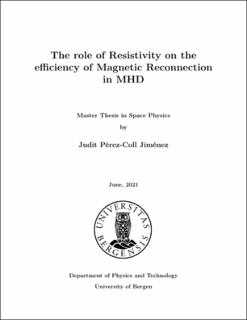The role of Resistivity on the efficiency of Magnetic Reconnection in MHD
Master thesis
Permanent lenke
https://hdl.handle.net/11250/2761424Utgivelsesdato
2021-06-01Metadata
Vis full innførselSamlinger
- Master theses [168]
Sammendrag
Magnetic reconnection is a fundamental plasma process, which can explosively convert magnetic energy to particle energy. When reconnection operates, it releases almost all of the energy stored in the magnetic field and accelerates and heats the plasma. The consequences of reconnection depend on the magnetic energy available and the process ability to rapidly release the energy. Thus, the effectiveness of reconnection, which can be quantified by the rate at which energy is converted, is a key factor in understanding consequences and implications of this universal process. It is critical to understand how effective reconnection operates. In this thesis, we investigate how the reconnection rate depends on the resistivity in the system. In our fluid-based scheme, resistivity refers, in simple terms, to the plasmas ability to diffuse across the magnetic field - allowing new magnetic topologies to form. We employ a resistive MHD model to study the fundamental physics of this question and show that, even when inserting very strong resistive spots with varying shapes, there appears to be a maximum rate of reconnection the system can support. In addition, we find that a sub-optimal choice of resistivity magnitude or shape of the resistive spot leads to lower overall reconnection rates. These results imply that the reconnection rate depends significantly on properties of the diffusion region, even if the size of that region is much smaller than the system. This is a new insight, which may be a counterpoint to the assertion that the reconnection rate is independent of the diffusion region physics. We find very strong indications that a maximum reconnection rate exists, and it appears exceedingly likely that this rate limitation is due to larger-scale system properties rather than properties of the diffusion region.
